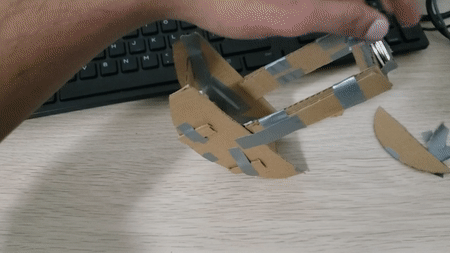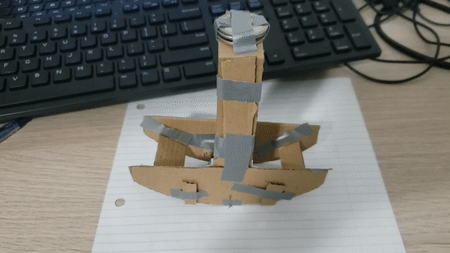Make forky walk - Sketching lab
Let me give some context. As part of the haptics course that I am taking this term, all of us have to try a few sketches. The idea was to use random stuff you find around you and come up with interesting skethces and iterate on it. The idea behind a sketch is to rapidly test different ideas to understand what works and what doesn’t. Now, thats the sane part of the “context”.
With a few days to the deadline, I am still trying figure out what I want to test. So, I am chatting with a friend, and as an expression of how lost I am I share this GIF with him. To which he responds “Please make a walking plastic spoon!”; that’s where the “walking forky” came from.
The idea
The first though that came to my mind is balancing toys. Making a forky that swing from side to side is pretty straight-forward: plant forky on a rocking base (I am not sure what the technical term for this is) with a weight at the bottom, and also maybe a smaller weight near the top and have it rock back and forth. The trick is going to be making it move forward. The “genius” idea I cam up with is to add little bumps on the rocking base to deliberately make the base make small hops forcing it move perpendicular to the rocking direction.
Iteration 1
To test this I started by cutting up an ikea cardboard box and test if I can make it swing. This was the sketch I cam up with for that:

This sketch had a bunch of coins as the weight at the base of the rocking base and also a few coins on the top of the arm to act as a weight to give it enough momentum to swing. But, it would not swing even with different weights at the top and bottom, which was probably due to the small radius of the rocking bottom.
Iteration 2
Building on this, I tried a second sketch with a larger radius which seems to give me a better result:


Now that I have a swinging toy, next up was to try make this move. For this I try to add bumps in the form of legs:

These legs will be only on one side of the base, and the idea is it will constantly trip the rocking base when it’s swinging, making it move forward. In this case, moving forward will be moving towards the side in which the legs are attached to the base. So I tested a few different configurations, with different angles for the legs, position along the base and the length of the leg. I arrive at a configuration that seems to give some result (PS: I didn’t think this will work at all):

Testing the “idea”
The are quite a few number of variables that can be adjusted to make this work better. But at this point I wanted to see if the idea actually does work.
In order to verify that it does actually move, I try swinging this sketch with and without the legs and record where they end up relative to a starting point. In the spirit of sketching (Minutes and hours/hours, a day levels according to Moussette’s levels of sketching), I simply use a piece of ruled paper to measure the distance moved. The started location was marked as the following:

Then for each condition, I position the sketch at the starting point, tilt it to one side and let go:

I mark the final location of the sketch. I did 10 trials for each. The results can be seen in the following image:

The starting points are marked with a red dot, with the final position marked with an “x"". (A) is with the leg, and (B) is without the legs. Note that, for (B) the resulting locations were practically the same as the starting point, it was barely distinguishable. In the image (A), down is the forward direction as I described above. So, it seems like my idea kind of worked. yay!
The “walking forky”
Now to build forky itself. I tried designing another sketch with more slimmer rocking base. But the prblem was attaching a form with coin tapped to it’s head was not straight-forward, even the mighty duct tape couldn’t help:

So I fell back to the second sketch I had made. I made a few modifications to that to be able to hold the fork, and voila, I have a forky that can kinda walk:
